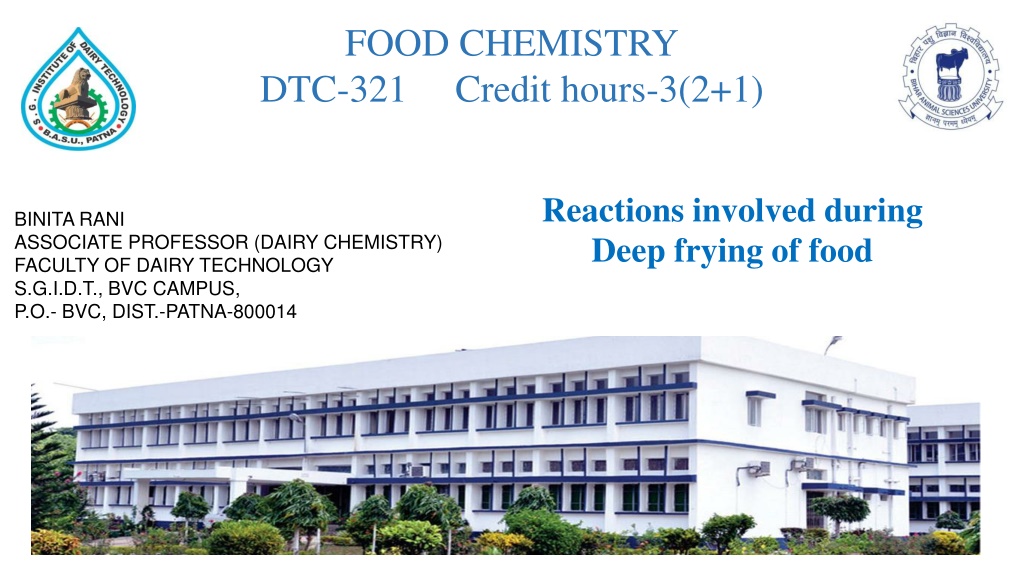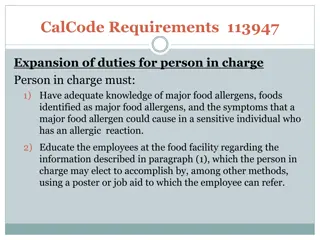Reactions and Behavior in Deep Frying of Food
The process of deep frying involves reactions that lead to changes in the chemical and physical properties of fats or oils, influencing the quality of the finished food products. Factors such as heat treatment, type of oil, and food impact the production of volatile compounds during frying. The behavior of frying oil changes due to oxidative reactions, leading to the production of various compounds. Food interactions with hot oil result in the absorption of oil, affecting the final fat content. Understanding the reactions and behaviors in deep frying is crucial for maintaining the quality of fried foods.
Download Presentation

Please find below an Image/Link to download the presentation.
The content on the website is provided AS IS for your information and personal use only. It may not be sold, licensed, or shared on other websites without obtaining consent from the author. Download presentation by click this link. If you encounter any issues during the download, it is possible that the publisher has removed the file from their server.
E N D
Presentation Transcript
FOOD CHEMISTRY DTC-321 Credit hours-3(2+1) Reactions involved during Deep frying of food BINITA RANI ASSOCIATE PROFESSOR (DAIRY CHEMISTRY) FACULTY OF DAIRY TECHNOLOGY S.G.I.D.T., BVC CAMPUS, P.O.- BVC, DIST.-PATNA-800014
Deep frying food preparation in home and in industry. Food products potato chips, meat, fish, prepared by frying into fat/oil heated to about 180 C. frying process food article sufficiently cooked consumed. Prolonged heating high temperature substantial changes chemical and physical properties fat or oil affects the quality of fat/oil & quality of finished foods. Short frying period production of desirable flavour and aroma organoleptic quality of product. In continuous deep fat frying large quantities of fat absorbed by food replenished by fresh frying oil steady state condition wherein it is unlikely that the oil deteriorates beyond a certain point. In intermittent frying cycles more rapid destruction of fat due to increase in hydroperoxides upon cooling their decomposition when fat is reheated. fats remain hot for long periods many heating and cooling
BEHAVIOUR OF FRYING OIL Deep fat frying different classes of compounds : 1. Volatiles Oxidative reactions lead to production of: alcohols, acids, esters, hydrocarbons, Ketones, lactones and Saturated & unsaturated aldehydes, Amounts of volatiles produced vary : type of oil, type of food and extent of heat treatment
2. Nonpolymeric polar compounds of moderate volatility e.g. hydroxyl & epoxy acids produced through oxidative pathways 3. Dimeric and polymeric acids and glycerides Thermal and oxidative free radicals polymerization substantial increase in viscosity of the frying oil 4. Free fatty acids Hydrolysis of triacylglycerol in presence of heat and water. These reactions responsible physical and chemical changes frying oil Increase in foaming tendency and viscosity Changes in flavor and colour (dark) Decrease in surface tension and iodine value Changes in refractive indices
Behaviour of food during frying Water food hot oil steam distillation effect sweeping volatile oxidative products from oil. Released moisture agitates the oil hastens hydrolysis. Blanket of steam above the surface of oil tends to the amount of oxygen oxidation Volatilesdevelop in food itself and/or from interactions between food and oil. Food absorbs varying amounts of oil 5 to 40% e.g., potato chips final fat content 35% Food release its endogenous lipids frying oil/fat e.g., fat from chicken oxidative stability of new mixture different from original frying oil/fat
CHANGES IN FRYING MEDIUM During deep fat frying : Hydrolysis, oxidation and polymerization Factors Temperature Method of heat transfer Presence of O2 Metals in contact with oil Heating time Turnover Frying capacity Nature of food being fried proportions of breakdown components in vegetable oils :
commonly observed chemical changes are: OXIDATION AND DECOMPOSITION Moisture, high temperature and atmospheric O2 favours the oxidation of frying medium. oxygen introduced into the oil with food oxidative changes. peroxide content of food begins to increase after an initial induction period and finally decreases. Major reactions during autoxidation degradation reactions formation of volatile compounds. Autoxidation of PUFA formation of conjugated hydroperoxides and peroxides decompose volatile acids, aldehydes, alcohols, ketones and hydrocarbons.
THERMAL OXIDATION In the presence of O2 when oil is heated at high temperature : Formation of free fatty acids Formation of hydroperoxides which may undergo : 1. Fission form alcohol, aldehydes and acids darkening of frying medium and flavour changes. 2. Dehydration form ketones 3. Formation of free radicals their combination to form dimers, trimers, epoxides, alcohols and hydrocarbons increase viscosity of the oil.
During deep frying thermal and oxidative decomposition of oil volatile and non- volatile products: 1. Volatile decomposition products: Most of them (generated during frying) removed by steam. They (e.g. unsaturated lactones) flavour 2. Non volatile decomposition products: Formed thermal oxidation and polymerization of unsaturated fatty acids (frying medium). Include cyclic acids, fatty acids, polymeric triglycerides, and other oxidative products. Accumulation of these products changes: increase in carbonyl value, FFA content, -OH content and saponification value and decrease in unsaturation Iodine value. Also increase in viscosity and refractive index.
POLYMERIZATION Oxidation and thermal alteration products undergo polymerization forming gums and residues. Rks b/w FA of same/different triglycerides cyclic and non-cyclic dimers and other polymeric compounds. Thermal polymerization of PUFA cyclic monomers, dimers, trimers and higher polymers. Rate of polymerization with increase in unsaturation of TG and frying time. This results changes darkening of colour, foaming, heat transfer rate, viscosity, molecular weight, and gum accumulation. Polymerization increased fatabsorption by food unpalatable and greasy.
HYDROLYSIS : Moisture from food during frying hydrolysis of fat increase in acidity initial formation of FFAs, mono and diglycerides and glycerols. Soaps of some fatty acids formed accelerate deterioration of frying medium. Accumulation of alkaline material the interfacial tension b/w product and frying medium decreases the food quality. Liberation of FFAs decrease in smoke point of oil. Colour , iodine value and viscosity of hydrogenated oils changes more rapidly at FFA levels of ~1.5%.























